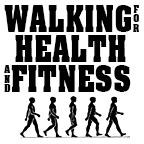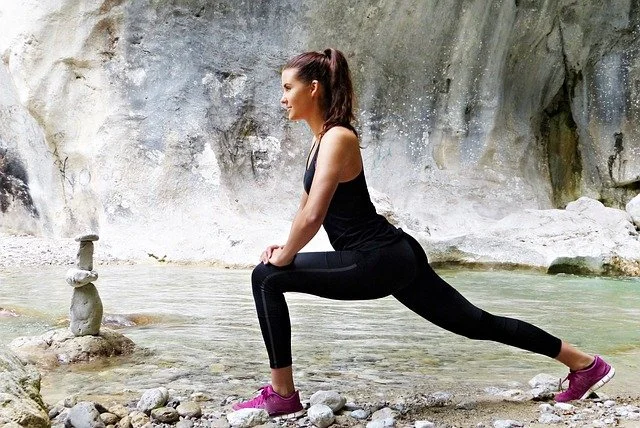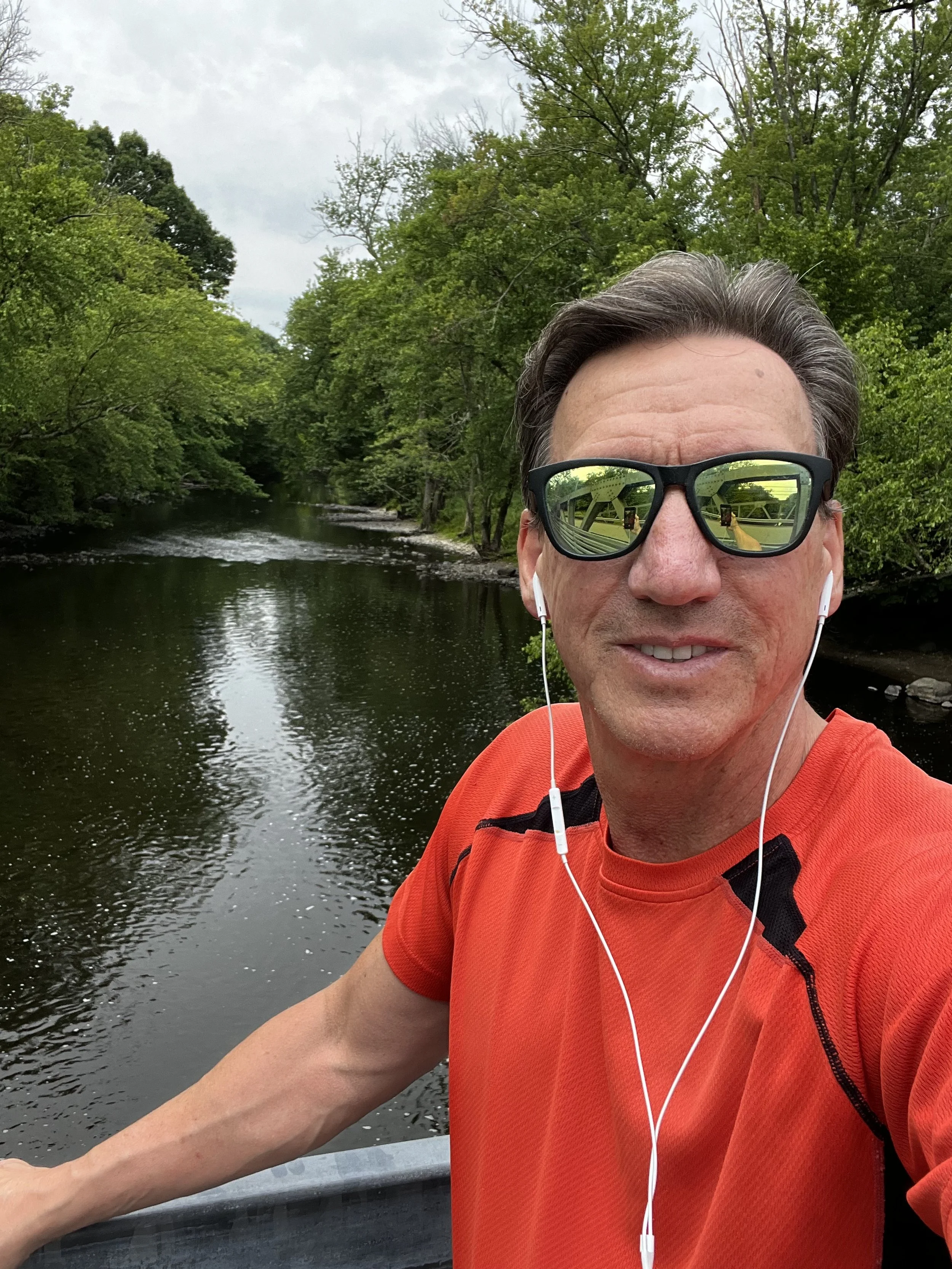Stretching for Health and Fitness Podcast Episode 14
Stretching after exercising offers several benefits to enhance your overall fitness and well-being. By stretching after walking or working out, you will experience improved flexibility and range of motion, enhanced muscle recovery, reduced muscle tension and stress, injury prevention, and improved athletic performance.
Success depends upon previous preparation, and without such preparation there is sure to be failure. – Confucius
And, Did I ever learn this lesson the hard and expensive way!
"Stop all activity; I don't want to operate on you." You never want to hear your doctor say these words to you. They got my attention big time!
Have you ever been injured exercising?
I sure have, and if you know my story, then you know how I severely injured my back from years of running. But there's more to it than just that.
Two things I never did as a runner were warming up before running and stretching afterward.
These were TWO HUGE COSTLY MISTAKES!
At most, I might have bent over to touch my toes right before I ran, but I later realized this did much more damage than any good.
Benefits of Stretching
Stretching increases your range of motion and flexibility by decreasing stiffness, making your soft tissues, such as muscles and ligaments, longer. But you must know when to stretch, and that's the key message of this podcast.
Stretching after exercising offers several benefits to enhance your overall fitness and well-being. By stretching after walking or working out, you will experience improved flexibility and range of motion, enhanced muscle recovery, reduced muscle tension and stress, injury prevention, and improved athletic performance.
Two Main Types of Stretches
• Dynamic stretches are controlled movements that prepare your muscles, ligaments, and other soft tissues for performance and safety.
• Static stretches are those in which you stand, sit, or lie still and hold a single position for up to 45 seconds.
Both stretches have different purposes and should be used at different times in your workout. I'll explain more in this podcast.
This episode is about avoiding the big mistakes most athletes make, even professionals.
Stretching for Health and Fitness… Learn More!
Dynamic vs. Static Stretching
For serious and not-so-serious athletes, stretching is crucial to playing or practicing a sport. Stretching increases your range of motion and flexibility by decreasing stiffness, making your soft tissues, such as muscles and ligaments, longer. It can also help improve your performance in your sport, help with soreness after exercise, and lower your chance of injury.
As mentioned in the introduction to this podcast, There are two main types of stretches: static and dynamic.
• Dynamic stretches are controlled movements that prepare your muscles, ligaments, and other soft tissues for performance and safety. Dynamic stretches are a warmup of your muscles, and you'll do these before your walk or fitness activity.
• Static stretches are those in which you stand, sit, or lie still and hold a single position for up to 45 seconds. Static stretching should be done after you have thoroughly warmed up.
I stretch after I have finished my walk, and the reason is simple. The walking motion is repetitive. I advocate walking because it is so gentle on the body. The walking stride generally doesn't vary; you do the same stride length step after step.
Frank S. Ring: Author
So, while walking is gentle on the body, your muscles repeatedly move the same length over and over again. When you complete your walk, you need to lengthen or stretch your muscles.
This type of stretching is the Static Stretching. You extend or stretch a specific muscle to the point of resistance and then a little bit more. You hold a stretch for 15-45 seconds. Then, release and repeat as often as needed.
An example of stretching is the calf muscle in your lower legs.
1. Standing up, holding on to a support, one leg is pushed backward and – with the knee extended – the entire sole of the foot is rested on the ground in such a way that the tension of the stretch is felt in the gastrocnemius which is the chief muscle of the calf of the leg.
2. The forward leg remains semi-flexed, supporting the body's weight as you lean forward.
3. You then hold this for 15-45 seconds and repeat as needed
4. This is an example of a static stretch.
five key advantages of incorporating stretching into your post-workout routine:
Stretching after exercising offers several benefits to enhance your overall fitness and well-being. Here are five key advantages of incorporating stretching into your post-workout routine:
Improved Flexibility and Range of Motion: Regular stretching helps to increase your flexibility by lengthening and loosening tight muscles and tendons. This leads to an improved range of motion in your joints, allowing for better overall movement and reducing the risk of injuries.
Enhanced Muscle Recovery: Your muscles may feel tight and tired after a workout. Stretching promotes blood flow to the muscles, delivering oxygen and nutrients while removing metabolic waste products. Stretching aids in muscle recovery, reducing post-exercise soreness and promoting faster healing.
Reduced Muscle Tension and Stress: Intense physical activity can cause muscle tension and tightness. Stretching helps to alleviate this tension by relaxing and lengthening the muscles, which can provide a sense of relief and relaxation. Stretching can also help reduce stress levels and promote a calm mental state.
Injury Prevention: Stretching is crucial in injury prevention by improving flexibility and addressing muscle imbalances. It helps to correct postural issues and counteracts the tightening effects of repetitive motions during exercise. Maintaining balanced muscle strength and flexibility reduces the risk of strains, sprains, and other exercise-related injuries.
Improved Athletic Performance: Incorporating post-workout stretching into your routine can positively impact your athletic performance. By enhancing flexibility, range of motion, and muscle recovery, stretching can improve your overall physical capabilities. Stretching allows you to perform exercises and sports movements more effectively, with greater power, speed, and agility.
Remember to listen to your body when stretching and avoid bouncing or overstretching, which can lead to injury.
As a reminder, stretching should never hurt. You should "feel" the muscle you are stretching, but if you feel PAIN… stop! My mantra is always, SLOW AND STEADY WINS THE RACE.
That said, a good body warmup is the key to staying injury-free.
Now that I've addressed why you should stretch, I must tell you why you should warm up.
I've put the cart before the horse, but I needed to address stretching first because most coaches and athletes, even us weekend warriors, all talk about needing to stretch more.
While stretching is essential, the warmup is the key to staying injury-free. This is what you do before walking or any workout.
The warmup is what will keep you injury-free. But, most of us spend the least amount of time on it, if any at all.
The warmup is the transition from inactivity to activity!
The warmup is Dynamic stretches and controlled movements that prepare your muscles, ligaments, and other soft tissues for performance and safety.
Dynamic stretches are warming up your muscles, and you'll do these before your walk or fitness activity.
But while they are called dynamic stretches, you're NOT necessarily focusing on a muscle and moving it to the point of resistance and then some as you do with static stretching.
You move your body in a controlled way that activates the muscle group and warms it up.
An example of a dynamic stretch is called an ankle circle. You slightly raise your foot off the ground and gently rotate it in a circular motion, clockwise for several rotations, then counter-clockwise for several rotations. Picture your big toe as a pencil, and you are drawing circles with it.
With this dynamic stretch, you are warming up your foot, ankle, and calf muscles and tendons.
Going back to our example of statically stretching the calf muscle. If your calf muscle is not adequately warmed up and you do a static stretch, then you can cause a tear in the muscle fibers. If you are aggressive with the static stretch, you can seriously injure yourself by stretching the cold calf muscle.
Now, you would naturally back off the static stretch of your calf if you felt pain, BUT… imagine that you didn't warm up, began a hike down a rocky trail, and had to step down off a rock to the next rock. That extension of a cold, stiff calf muscle and your weight coming down on it could be more than enough to damage the muscle.
Have you ever tried using a rubber band sitting in your desk drawer for far too long? What happened when you stretched it? Chances are it snapped. I don't want this happening to your muscles.
A quick warmup with dynamic stretches, I feel better saying controlled body movements, are the way to go.
The Wisdom of Warming Up: The Big Mistake Most Athletes Make
Just like trying to start your car on a cold morning, your body must also warm up before you can get the most out of it.
The Purpose of a Warm-up is to:
· Increase blood flow to your muscles.
· Loosen muscles, joints, tendons, and ligaments.
· Allow you to move more freely.
· Cut the risk of injury.
· Get the brain engaged.
The American College of Sports Medicine considers warming up an essential part of any type of workout.
Warming up is a transition between rest and activity.
The Perfect Warm-Up: Crucial but not complicated
· Squats
· Lunges
· High Knees
· Calf Raises
· Ankle Circles
· Leg Swing (Hold a chair or wall for support)
· Pelvic Loop (Hip Circles)
· Arm Circles
So, why don't you do more dynamic stretching to warm up and static stretching after we complete our walk?
Chalk this up to these factors:
You may not know the difference between dynamic and static stretches.
You’ve not learn the importance of each and when to perform them.
In my research, is what I call friction points: A friction point is that thing that makes a task difficult to accomplish.
You feel pressed for time. You don't warm up because you want to get started with your walk or other activity.
You may be sweaty after exercise; do you want to lie on the grass and stretch?
Some people have a hard time getting up off the floor: If you've just begun a fitness routine and are not in shape yet, then the thought of getting up and down from the floor is a friction point. Without these friction points, you're more likely to perform the stretching routine.
You are standing for most sporting activities: Whether walking, running, softball, pickleball, tennis, basketball, skiing, or golf, you don't do sports lying down. So why should you have to lie down to stretch your body?
The Stretching for Health and Fitness Course
I've got an excellent solution for you and how you can make your warmup and stretching routine automatic.
I call it my Stretching for Health and Fitness Course: “Get looser, Feel Freer, walk faster, and live longer.” The course is hosted on the Teachable Creators Platform.
Here's the critical component of my course: My stretching routine is done from the upright position. You do the stretches while standing.
This reduces the friction points I previously mentioned: A friction point is that thing that makes a task difficult to accomplish. You may be sweaty after exercise. Do you want to lie down in the grass and stretch?
The Stretching for Health and Fitness Course Includes:
Learn More: Stretching for Health and Fitness
• Five videos that get right to the point so you can learn and apply my warmup and stretching principles.
• 36-page Stretching for Health and Fitness Course Booklet.
• 3 Audio Tracks: The Warmup, Stretching with Explanation, and Stretching with Music that guides you through each workout phase.
• Stretching Progress Chart.
The Course Includes Bonus Content Downloads:
• Audiobook Version of Walking for Health and Fitness ($20 Value)
• Walking Inspiration Quarterly Newsletter ($24 Value)
• Get Out the Door Checklist (Priceless)
• 5 Rituals to Happiness and Fulfillment
• 10 Tips to Perfect Your Walking Form
• 40 Inspirational Walking Quotes
• The Power of Plant-Based Nutrition
• AND MORE!
HOSTED ON THE TEACHABLE PLATFORM, YOU'LL GET:
• Personalized Unique Login
• Lifetime access to the program
• Safe and secure payment system
• 14-Day Money-Back Guarantee
My Course’s audio tracks make your stretching routine nearly automatic:
• Before you work out, listen as I guide you through a gentle warmup for your whole body in just 7 minutes.
• After you work out, I guide you through 11 easy-to-learn and perform stretches that begin at your feet and end at your neck.
Check out my Stretching for Health and Fitness Course. Then, Follow my 7-minute guided warmup routine before you walk, and my guided stretching routine after you walk.
Walk on,
Frank S. Ring
Author: Walking for Health and Fitness, Fitness Walking and Bodyweight Exercises, Walking Inspiration, and Walking Logbook Journal.












